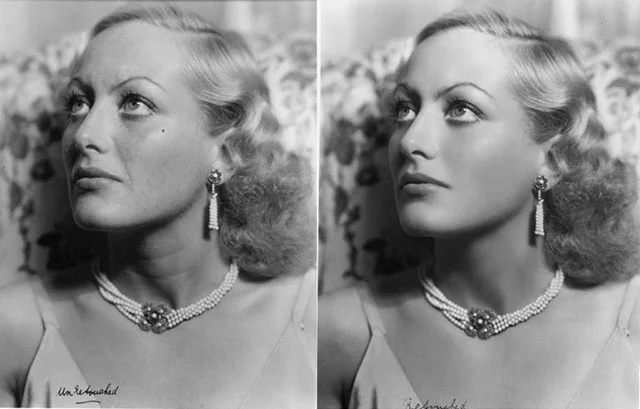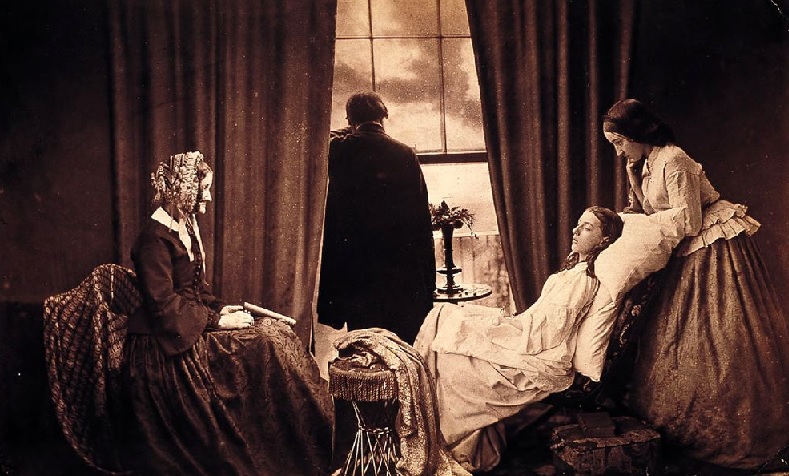
A very good, if not wordy, question worthy of consideration in this latest photo retouching blog.
So we duly did.
First we gave you ‘Old School Retouching’. Which explained how retouching artists of their day invented techniques – and graphic improvisations – so as to visually correct or enhance images. Pre-Photoshopping. Then we spoiled you with our ‘Potted History of Photoshop’. We even treated you to ‘What was the first Photoshopped Image?’
Because we’re like that*
*Thoughtful/informative/compelling reading
However we’ve left you completely in the dark (room) when it comes to the equally important matter of just who invented photo retouching. As in pre-Photoshop, obviously. And as in from an actual photography/image-creating angle.
Shock! Horror! Photographers Invented Photo Retouching (the clue’s in the title)….
A shock to any readers born after the last Millenium, maybe. Yet we can confirm that image editing techniques WERE being practiced by photographers (and not, as potentially imagined, by much sought-after digital photo retouchers like DT) many, many moons ago. Before most of us were even thought about.
And way before the Adobe Brothers were getting hip to the hop over Photoshop. Even before Neil Armstrong was setting foot on the abovementioned lunar surface.
And one name more than any other keeps cropping up when we trawl the internet archives to determine just who was first guilty of fiddling with existing photographic imagery. All in the name of enhancement/beautification. Or just plain, good old-fashioned tooling around.
Only minus graphic software tools.
And that name belonged to an American called Ansel Adams.
For it was he who is widely credited as being amongst the very first of the creative photographer types to dabble in the dark arts. Which went on to become globally recognised as photo enhancement. Or image manipulation, if we’re keeping a weather eye on SEO.
And to put this in perspective, we’re rewinding the timeline clock back to the 1920s and monochrome pictures. Which required the application of light exposure techniques in a conventional photographer’s dark room. Which was a lot more trial and error in execution than twiddling some Photoshop knobs, we should coco.
And perserverance. The very sort which would trouble even a saint, according to historical adages.
Come Again. What is Photo Manipulation?
In Layman’s terminology, photo manipulation is the act/creative process which results whence a digital image editor applies various methodologies and principles to the subject of photo metamorphosis. Or to put it in other words. Which is all fair and well in this image editing software age in which we live/work. However this wasn’t always the case of yore.
Photographic retouchers (typically those who practised professional photography for a living) relied heavily on darkrooms rather than laptops to weave their image magic. A whole host of relatively rudimentary equipment and techniques were applied to the tasks in hand. Scratching, sandwiching and/or overpainting of negatives, vibrating while exposing, blurring, colouring, photomontage and combination printing were all the rage. Pre-Photoshopping.
And along with the more basic fundamentals of airbrushing and dodging and burning, were routinely facilitated so as to photographically capture events of historical relevance and politically-motivated importance. Not simply to serve the needs of the fashion or beauty industry. Or alternatively, to manifest imagery which appeared to mimic paintings and more traditional works of art doing the rounds at the time.
When Did It ALL Start Then? This Photo Editing Lark?
You might have hitherto thought that digital retouchers like us have got Photoshop to thank for making us the successes we are today. But that’s not entirely true. Plus we’ve already dispelled that theory. What’s more, it would be a disservice to our naturally-occuring skillsets. As analog post-processing began in the 19th Century; borne out of photographical experimentation.
In the 19th Century, many photographers experimented with hand-tinting of their portraits. To give them a more vivid and life-like look and feel. Elsewhere, others would compose large group portraits by photographing individuals separately in the studio. Then creating a post-photo shoot collage by way of pasting them onto painted backgrounds. More often than not depicting outdoor scenes.
But then along came people like Henry Peach Robinson. A photographer who was enthusiastically giving photo compositing techniques a go as early as 1858 (year, not time). While George Hurrell was Hollywood-ising Joan Crawford – and her skin tone/complexion – a few decades later in 1931.

Hollywood Got in on the Whole Image Retouching Act Too, Didn’t You Know
With regards to the former, perhaps Robinson’s most instantly recognizable image is that of an ill and bed-ridden young woman in the centre-ground to ‘Fading Away’. This manually-constructed composite photograph is the direct result of what was referred to as ‘combination printing’. Which essentially saw the fusing together of different negatives, coupled with the principle elements of over exposure.
Concentrating on the latter example, and Hurrell’s glamour shot of screen siren, Crawford at the beginning of the 1930s remains one of the very best illustrations of photo retouching. As it was found at the very inception of superficially-focused image enhancing by the Hollywood machine.
The visual embellishing of a face.
Which of course, has experienced a systematic evolution through the subsequent decades. Culminating in today’s very contemporary photo-filtering apps downloadable to our smartphones. And testament to the underlying fact that seeking out the perceived ‘perfect body/face’ image was in motion long before the advent of both Photoshop (from a commercial stance) and the abovementioned apps.
In terms of how Crawford’s visage was subjected to pictorial revisions, Hurrell’s retoucher, James Sharp described a process whereby he’d smooth the actress’s skin and remove the fine lines to ensure that her face appeared more youthful. This was achieved courtesy of a retouching machine. Operated via a series of controls which actively vibrated the negatives. Thus affording the retoucher the platform to then manually paint away the blemishes. Including freckles.

Adam’s Apple Moment
But returning to Ansel Adams, and a name synonymous with photo retouching; largely thanks to his game-changing 1941 compositional piece, entitled ‘Moonrise’.
Still lauded in the digital image enhancing sector as the master of darkroom dodging and burning techniques, Adams was instrumental in changing the future landscape of photographic retouching. And landscapes just happened to be his ‘thing’ any way.
The photo retoucher’s photo retoucher was responsible for the advent of the ‘zone system’. And Adams’ post-processed images fired the imaginations and highlighted what dynamic effects were previous believed to be virtually impossible. Traffic-stopping effects in many cases, especially when contrasted with what had been observed up until that seemingly transitional juncture.
We don’t exagerate when we say that the creative world of the early 1940s sat up and took note when in 1941 Adams whipped the dust covers off ‘Moonrise’. And almost singlehandedly changed the way we viewed image manipuation and rationalised elementary photographical captures.
The Photo Retoucher’s Photo Retoucher
Shot in New Mexico as the day was ending, the monochrome photograph depicts a rising moon. Pictured in an immense sky dominated by the impending blackness of the rapidly encroaching nightfall. Beneath the steely gaze of the moon, a collection of dwellings and a church, along with snow-covered mountains are observed.
Standing as one of the most iconic photographic images in history, Adams perfectionistic approach to the darkroom treatments which followed significantly added to his enduring sense of legend.
Adams spoke at the time about ‘Moonrise’, describing how he’d achieved the final composition and what photo retouching techniques he’d administered.
Adams; “The sky was of such low saturation blue that no filter would have had much effect… Considerable burning (darkening) and dodging (lightening) are required.”
He went on to add; “I hold back the shadowed lake and foreground for about three-fourths of the exposure time, using a constantly moving card held relatively close to the lens,” concluding; “The lake surface is burned in later to balance the amount of dodging of the surrounding hills and foreground.”
Debunking the myths that pre-digital era image-making was untouched and was a product of a camera and the equipment alone, this blog uncovers where it began. And draws the conclusion that digitalization is pretty much the only key difference between processes available during the last century, and today. Making for faster and more exacting detailing.
And moreover, we’ve learned who the pioneers of photo retouching were.

